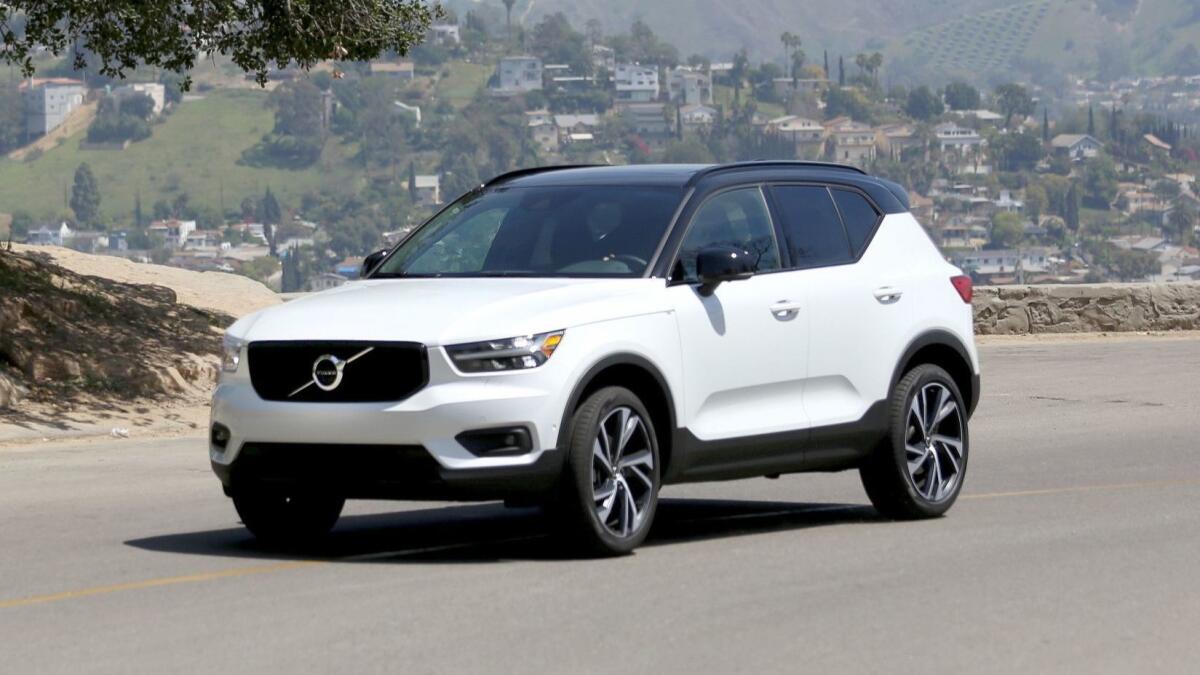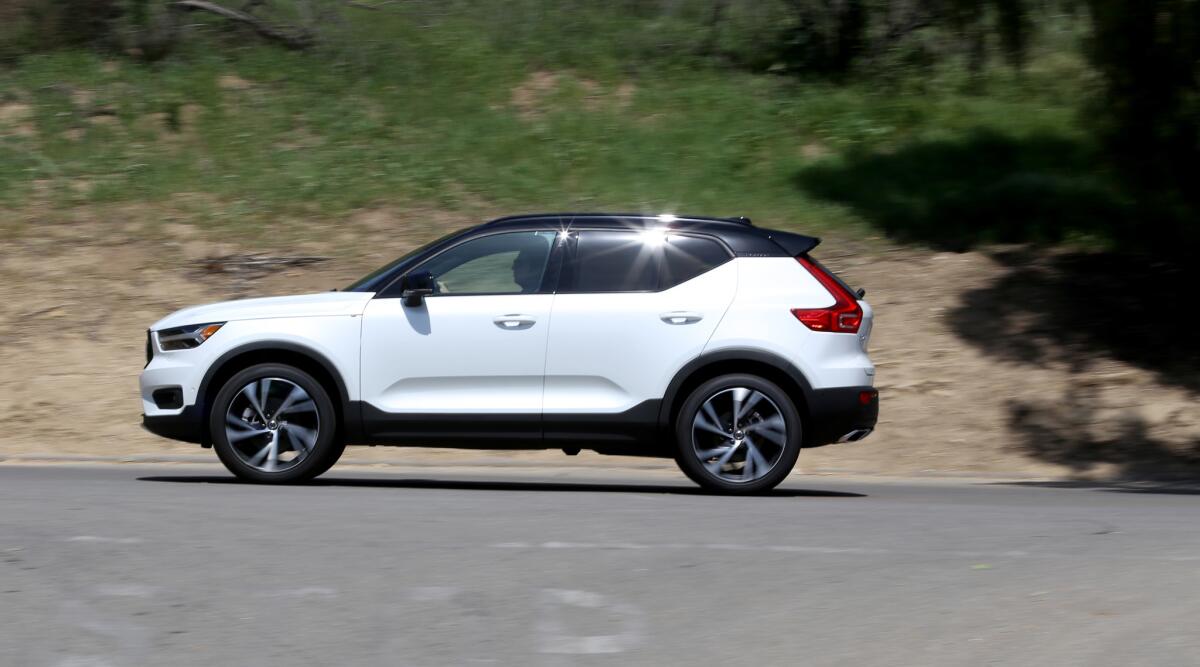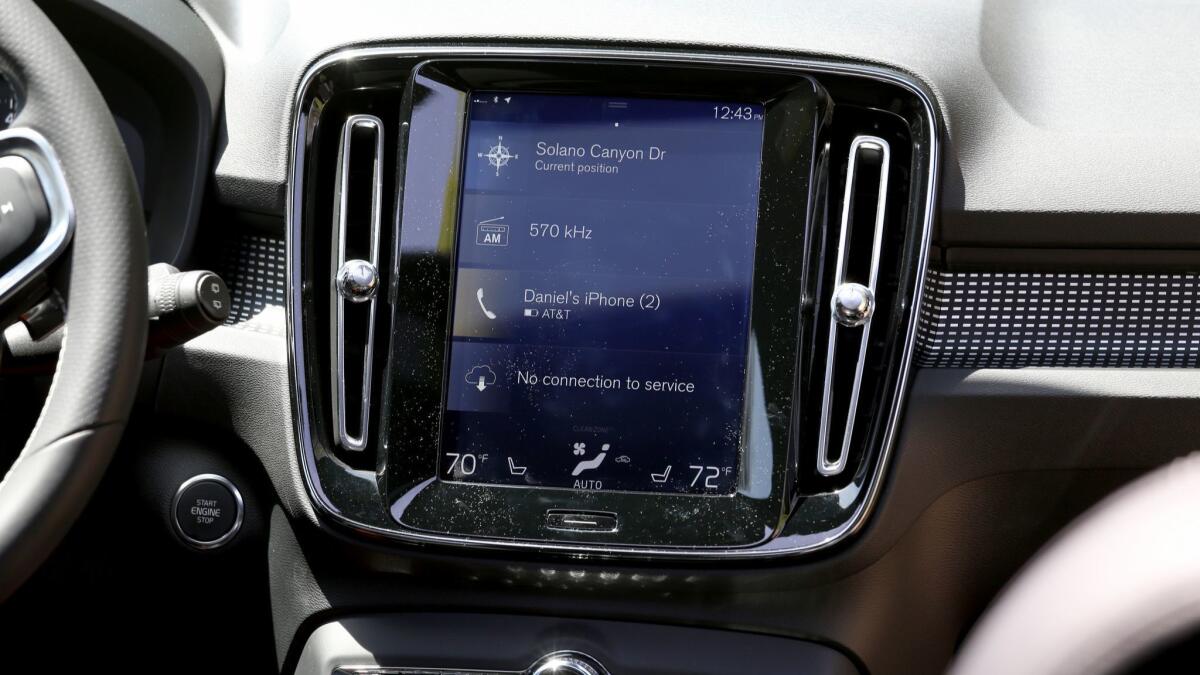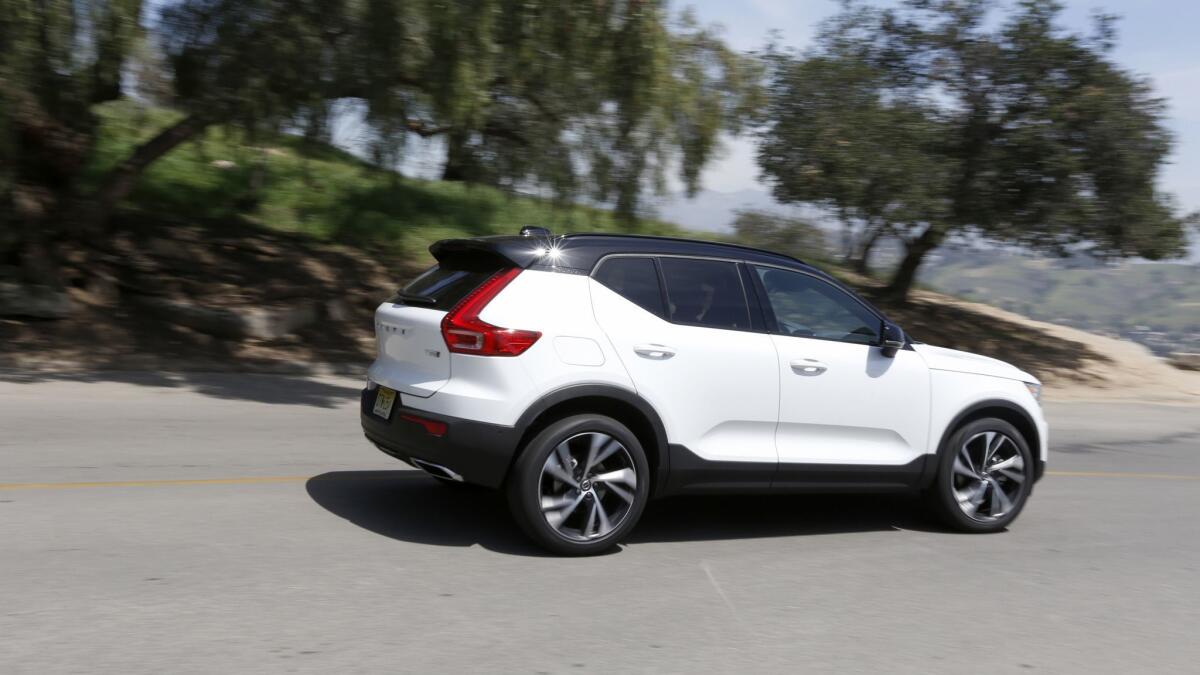Just like underwear, wine and vitamins: You can subscribe to the Volvo XC40

- Share via
You’ve grown accustomed to subscribing to all manner of products and services: underwear, cosmetics, razor blades, coffee, music, wine, movies, charcuterie, vitamins, meal kits.
All of it can be had for a set-it-and-forget-it monthly fee. But could this same model, which has flourished in the Internet age, work for a car?
Volvo is betting on it. It is the first carmaker to debut a nationwide subscription service, Care by Volvo, which launched late last year. The company said this month that by 2025, it expects half of all cars it offers to customers to come from the subscription service.
The program’s opening offering is the 2019 XC40 sport utility vehicle, the smallest and least expensive of the Swedish automaker’s three SUVs. It is the logical vehicle for the launch of the program. It’s a car that style-minded millennials and young parents — many of whom are already firmly ensconced in the subscription economy — are likely to consider.
It costs $600 a month for two years, or $700 for a more fully optioned R-Design variant. The monthly fee covers insurance, roadside assistance, repairs and scheduled maintenance. The price doesn’t include local taxes or registration.
In places where insurance rates are inordinately high, paying for an XC40 via subscription could be a better deal than purchasing or leasing the car.

Volvo isn’t the only auto manufacturer experimenting with subscriptions. Cadillac, Porsche, BMW and others also are dabbling in the space, albeit with pricier plans that are less widely available.
Though Care by Volvo is less expensive than its competitors, subscribing to an XC40 isn’t meant to be an economical choice. It’s about convenience.
“It’s not like when you go to McDonald’s and you get a value meal,” said Volvo spokesman Jim Nichols.
The program is meant to “overcome the friction some customers have in acquiring and owning a vehicle,” he said. “We found a lot of people entering into car ownership for the first or second time found themselves overwhelmed by the options available.”
The subscription model could portend bigger changes in the automotive world.
“What we are really testing the waters for is autonomous vehicle ride-sharing,” said Ivan Drury, an analyst for Edmunds. “Can we get people acclimated to the idea of [switching] cars often?”
Volvo will benefit from reams of data generated by its new program that could be used to tailor future initiatives. “The learning will be really insightful — to see how consumers will approach car ownership in the future,” Drury said.
For now, though, you’ll have to actually drive your XC40.
After a week tooling around in one, I came away more interested in the subscription model than the SUV itself. The car is competent, sure, but it’s merely that — which could be a problem in an ultra-competitive segment where luxury automakers, including Audi, Mercedes-Benz and BMW, all sell well-honed competitors.
Our test car — an XC40 T5 AWD R-Design that cost $45,935 — came loaded with options, making it essentially equivalent to the $700-a-month subscription offering.
The tester featured a two-tone paint job with a blacked-out roof that made the car look more svelte and speedier than it is. The turbocharged four-cylinder motor churns out 248 horsepower, but feels overly subdued until the dynamic driving mode is activated, significantly changing throttle response to make the all-wheel-drive SUV a more engaging driver. Still, the steering is far too light and vague, and the brakes feel grabby. The car doesn’t seem to enjoy being flogged, even though it does 0 to 60 in an estimated 6.2 seconds.
Inside, an artful mix of materials — patterned metallic trim, perforated leather and nubuck upholstery — feels decidedly high-end.
The paddle shifters, for example, are plastic but give the impression that they are crafted from metal. The backs of the paddles — where you’ll place your hands when shifting in manumatic mode — are coated in grippy rubber. They feel luxurious in hand — better than the ones in $100,000-plus grand tourers from the likes of Mercedes. The rubber backing is an artful touch, one that is largely unseen but reveals a keen attention to detail.
The well-designed interior aside, the XC40’s 9-inch Sensus touch-screen system, which controls nearly all of the SUV’s functions, is a major letdown.
It presents a clunky and maddeningly frustrating interface: slow at times and largely unintuitive. There are few redundant physical controls, making it tough to bypass the portrait-oriented screen. This makes even the simplest of actions, such as adjusting the heat or air-conditioning, unnecessarily laborious.

It’s particularly frustrating because many car companies — Genesis and Lexus among them — seem to have figured out the right balance between physical and screen-based controls. (The Sensus system does offer Apple CarPlay and Android Auto compatibility, which could improve your experience depending on your comfort level with those interfaces.)
Because this is a Volvo, there’s an array of safety features on offer. Our test vehicle included the $1,100 vision package, which includes a cross-traffic alert and auto-brake system that can stop the car to avoid a collision.
For much of my week with the XC40, I was annoyed by the feature, because on a few occasions, it engaged when it wasn’t needed, and the vehicle startlingly slammed on the brakes in an attempt to avoid some imagined impending catastrophe.
And yet, in one instance, it saved me from a wreck. I was backing out of a parking space in a garage and didn’t see an SUV barreling around the corner. Sure enough, the XC40 slammed on the brakes. Surprised, I looked in the rearview mirror and saw the car speeding by.
You can, of course, buy or lease the XC40 the old-fashioned way; it starts at $34,195 and lease deals listed on Volvo’s website in mid-June began at $325 a month.
However, the subscription service is meant to wipe away the annoyances and responsibility of buying and maintaining a car (think: haggling over the price with a salesman and shopping for insurance).
Overall, the subscription process is straightforward: Prospective customers sign up online, select their vehicle and put down a refundable $500 deposit.
From there, Volvo and insurance partner Liberty Mutual review the customer’s application, and if it all pencils out, they reach out to make delivery plans at a dealership.
But there is plenty of fine print. The subscriber is on the hook for the entire two-year term — there is no early-termination fee. And subscribers are capped at 15,000 miles per year.
Nichols declined to disclose the number of people who have subscribed to the XC40 since the program launched in November (customers began receiving cars in May), or the per-vehicle profit realized by the company. However, he said that 92% of U.S. subscribers are new to the brand — and business has been brisk.
“We have completed a year’s worth of projected subscriptions in three months,” he said.
But the competition is growing.
Although subscription programs from Cadillac, Porsche, BMW and others are not yet offered nationally, their luxury services allow customers to swap in and out of different vehicles. Those programs are more expensive, starting at $1,500 a month.

Volvo, instead, is charging you a fee for your car for two years.
Analysts are waiting to see how customers respond to the program, which will expand this fall to include the new S60 sedan, whose monthly subscription fee will start at $775.
Mike Ramsey, a transportation and mobility analyst at Gartner Inc., said that if Volvo’s service works well, it could entice many more consumers.
“I suspect it will do pretty well for them if they can make it work,” he said. “But can they make it work as advertised? They are basically doing a whole cadre of things they weren’t doing before.”
As someone who subscribes to several services — among them ones that deliver paper towels, music, movies and coffee to my home, I could see doing the same for my car.
But only for the right one.
XC40 T5 AWD R-Design
Times’ take: A stylish, subscribable SUV with a few big flaws
Highs: Offered via an innovative subscription service
Lows: Dreadful touch-screen interface, iffy driving dynamics
Vehicle type: Four-door, five-passenger sport utility vehicle
Base price: $37,700
Price as tested: $45,935
Powertrain: 2.0-liter, turbocharged, I-4 gasoline engine
Transmission: Eight-speed automatic
Horsepower: 248
Torque: 258 pound-feet
Estimated fuel economy rating: 23 miles per gallon city / 31 highway / 26 combined
Twitter: @DanielNMiller







